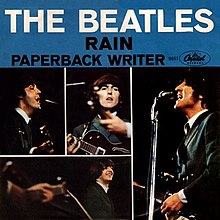Rain (Beatles song)
| "Rain" | |||||||||||
|---|---|---|---|---|---|---|---|---|---|---|---|

US picture sleeve
|
|||||||||||
| Single by The Beatles | |||||||||||
| A-side | "Paperback Writer" | ||||||||||
| Released | 30 May 1966 (US) 10 June 1966 (UK) |
||||||||||
| Format | 7" | ||||||||||
| Recorded | 14 and 16 April 1966 EMI Studios, London |
||||||||||
| Genre | Psychedelic rock | ||||||||||
| Length | 2:59 | ||||||||||
| Label | |||||||||||
| Writer(s) | Lennon–McCartney | ||||||||||
| Producer(s) | George Martin | ||||||||||
| The Beatles UK singles chronology | |||||||||||
|
|||||||||||
|
|||||||||||
"Rain" is a song by the English rock band the Beatles first released in May 1966 as the B-side of the "Paperback Writer" single. Both songs were recorded during the sessions for the album Revolver although neither appears on that album.
Written by John Lennon although credited to Lennon–McCartney, "Rain" has been called the Beatles' finest B-side, noted for its slowed-down rhythm track and backwards vocals, both of which were a hint of things to come on Revolver, released two months later. Music critic Jim DeRogatis describes it as "the Beatles' first great psychedelic rock song". The single's release marked the first time that reversed sounds had appeared in a pop song, although the Beatles used the same technique on the Revolver track "Tomorrow Never Knows", released in August 1966.
Three promotional films were made for the song "Rain". These videos, along with other Beatles videos at the time, sparked George Harrison to say during the Beatles Anthology, "So I suppose, in a way, we invented MTV."
The inspiration for "Rain" is agreed on by Neil Aspinall, the Beatles' roadie, and John Lennon. They both described the band's arrival in Sydney, Australia, marked by rain and poor weather. Lennon said, "I've never seen rain as hard as that, except in Tahiti", and later explained that "Rain" was "about people moaning about the weather all the time". Another interpretation is that the song's "rain" and "sun" are phenomena experienced during a benign LSD trip.
While technologically elaborate, "Rain" has a simple musical structure. Set in the key of G major (the final mix pitches it about a quarter of a semitone below this, while the backing track was taped in G sharp), it begins with what Alan W. Pollack calls, "a ra-ta-tat half-measure's fanfare of solo snare drums", followed by a guitar intro of the first chord. The verses are nine measures long, and the song is in 4/4 time. Each verse is based on the G, C, and D chords (I, IV, and V). The refrain contains only I and IV chords, and is twelve measures long (the repetition of a six-measure pattern). The first two measures are the G chord. The third and fourth measures are the C chord. The third measure has the C chord in the so-called 6/4 (second) inversion. The fifth and sixth measures return to the G chord. Pollack says the refrain seems slower than the verse, though it is at the same tempo, an illusion achieved by "the change of beat for the first four measures from its erstwhile bounce to something more plodding and regular". After four verses and two refrains, a short solo for guitar and drums is played, with complete silence for one beat. What is heard next is what Pollack calls "historically significant" reverse lyrics. The Beatles pioneered the fade-out fade-in coda that was later used on "Strawberry Fields Forever" which can also be heard on Led Zeppelin's "Thank You".
...
Wikipedia
